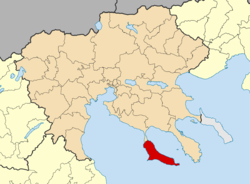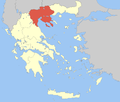Kassandra, Chalkidiki: Difference between revisions
Rescuing 1 sources and tagging 0 as dead. #IABot (v1.3beta8) |
Merge from Pallene (Chalcidice) following uncontested 2014 merge proposal; older name for the same place fits well within the History section |
||
| Line 28: | Line 28: | ||
|elevation_max = |
|elevation_max = |
||
}} |
}} |
||
| ⚫ | '''Kassandra''' (Κασσάνδρα) or '''Kassandra Peninsula''' (Χερσόνησος Κασσάνδρας) is a peninsula and a municipality in [[Chalkidiki]], [[Greece]]. The seat of the municipality is in [[Kassandreia]].<ref name=Kallikratis>[http://www.kedke.gr/uploads2010/FEKB129211082010_kallikratis.pdf Kallikratis law] Greece Ministry of Interior {{el icon}}</ref> |
||
{{Merge from|Pallene, Chalcidice|date=November 2014}} |
|||
| ⚫ | |||
==Municipality== |
==Municipality== |
||
| Line 40: | Line 38: | ||
==History== |
==History== |
||
===Pallene=== |
|||
{{For|other Pallenes|Pallene (disambiguation){{!}}Pallene}} |
|||
[[File:Chalcidice.jpg|thumb|300px|Headland of Pallene in ancient Chalcidice]] |
|||
'''Pallene''' ({{lang-el|Παλλήνη}}) is the ancient name of the westernmost of the three headlands of [[Chalcidice]], which run out into the [[Aegean Sea]].<ref>{{SmithDGRG|title=Pallene}}</ref> It is said to have anciently borne the name of '''Phlegra''' ({{lang|grc|Φλέγρα}})<ref>Herodotus. ''Histories'', vii. 123.</ref> and to have witnessed the conflict between the gods and the earthborn [[Gigantes]].<ref>Pind. ''Nem.'' i. 100, ''Isthm.'' vi. 48; Apollod. i. 6. § 1; [[Lycophron]] 1408; [[Strabo]] vii. p. 330; [[Stephanus of Byzantium|Steph. B.]] ''s. v.''</ref> The modern name of the peninsula is [[Kassandra, Chalkidiki|Kassandra]], which, besides affording excellent winter pasture for cattle and sheep, also produces an abundance of grain of superior quality, as well as wool, honey, and wax, besides raising silkworms.<ref>[[William Martin Leake]], ''Northern Greece'', vol. iii. p. 163.</ref> In antiquity, Pallene was the site of numerous towns: Sane, [[Mende (Chalcidice)|Mende]], Scione, Therambos, Aege, [[Neapolis, Chalcidice|Neapolis]], Aphytis, which were either wholly or partly colonies from [[Eretria]]. |
|||
[[Strabo]]<ref>( VII.27 Fragments )</ref> mentions the following five cities of Pallene in the 1st century BC ([[Cassandreia]], [[Aphytis]], [[Mende (Chalcidice)|Mende]], [[Scione]] and [[Sane (Pallene)|Sane]]). |
|||
After the founding of the Roman colony of Cassandreia (43 BC), the entire peninsula of Pallene was included in the colony territory. <ref>[http://olympias.lib.uoi.gr/jspui/bitstream/123456789/6116/1/13.%20%CE%97%20%CF%81%CF%89%CE%BC%CE%B1%CF%8A%CE%BA%CE%AE%20%CE%B1%CF%80%CE%BF%CE%B9%CE%BA%CE%AF%CE%B1.pdf] D. C. Samsaris, The Roman Colony of Cassandreia in Macedonia (Colonia Iulia Augusta Cassandrensis) (in Greek), Dodona 16(1), 1987, p. 353-362 </ref> |
|||
===Late Roman=== |
|||
In [[Late Antiquity]], the center of the peninsula was the city of [[Cassandreia]], located at the site of ancient [[Potidaia]]. A ''[[polis]]'' and a bishopric, Cassandreia was destroyed by the [[Huns]] in 539 or 540 AD.<ref name="ODB">{{cite encyclopedia | last1 = Gregory | first1 = Timothy E. | author1-link = | last2 = Kazhdan | first2 = Alexander | author2-link = Alexander Kazhdan | title = Kassandreia | page = 1109 | editor-last=Kazhdan | editor-first=Alexander | editor-link=Alexander Kazhdan | year=1991 | encyclopedia = [[The Oxford Dictionary of Byzantium]] | location = Oxford and New York | publisher=Oxford University Press |isbn=978-0-19-504652-6 }}</ref> After this, Emperor [[Justinian I]] built a wall at the entrance of the peninsula, but it is not until the 10th century that a sizeable settlement—described as a township (''polichnion'') and later as a fortress (''kastron'')—re-appears in the peninsula and that the bishopric is mentioned again, as a [[suffragan]] of [[Thessalonica]].<ref name="ODB"/> The area prospered due to its fertility, and both Thessalonians as well as the monks of the growing monastic community at nearby [[Mount Athos]] had estates there.<ref name="ODB"/> |
In [[Late Antiquity]], the center of the peninsula was the city of [[Cassandreia]], located at the site of ancient [[Potidaia]]. A ''[[polis]]'' and a bishopric, Cassandreia was destroyed by the [[Huns]] in 539 or 540 AD.<ref name="ODB">{{cite encyclopedia | last1 = Gregory | first1 = Timothy E. | author1-link = | last2 = Kazhdan | first2 = Alexander | author2-link = Alexander Kazhdan | title = Kassandreia | page = 1109 | editor-last=Kazhdan | editor-first=Alexander | editor-link=Alexander Kazhdan | year=1991 | encyclopedia = [[The Oxford Dictionary of Byzantium]] | location = Oxford and New York | publisher=Oxford University Press |isbn=978-0-19-504652-6 }}</ref> After this, Emperor [[Justinian I]] built a wall at the entrance of the peninsula, but it is not until the 10th century that a sizeable settlement—described as a township (''polichnion'') and later as a fortress (''kastron'')—re-appears in the peninsula and that the bishopric is mentioned again, as a [[suffragan]] of [[Thessalonica]].<ref name="ODB"/> The area prospered due to its fertility, and both Thessalonians as well as the monks of the growing monastic community at nearby [[Mount Athos]] had estates there.<ref name="ODB"/> |
||
| Line 56: | Line 64: | ||
== References == |
== References == |
||
{{reflist}} |
{{reflist}} |
||
{{Kallikratis-Central Macedonia}} |
{{Kallikratis-Central Macedonia}} |
||
| Line 65: | Line 74: | ||
[[Category:Landforms of Central Macedonia]] |
[[Category:Landforms of Central Macedonia]] |
||
[[Category:Landforms of Chalkidiki]] |
[[Category:Landforms of Chalkidiki]] |
||
[[Category:Headlands of Greece]] |
|||
[[Category:Geography of ancient Chalcidice]] |
|||
Revision as of 11:54, 14 July 2017
Kassandra
Κασσάνδρα | |
|---|---|
Settlement | |
 Kassandra municipality | |
| Coordinates: 40°03′N 23°25′E / 40.050°N 23.417°E | |
| Country | Greece |
| Administrative region | Central Macedonia |
| Regional unit | Chalkidiki |
| Area | |
| • Municipal unit | 206.1 km2 (79.6 sq mi) |
| Population (2011)[1] | |
| • Municipal unit | 10,760 |
| • Municipal unit density | 52/km2 (140/sq mi) |
| Time zone | UTC+2 (EET) |
| • Summer (DST) | UTC+3 (EEST) |
| Postal code | 631 00 |
| Area code(s) | 23710 |
| Vehicle registration | |
Kassandra (Κασσάνδρα) or Kassandra Peninsula (Χερσόνησος Κασσάνδρας) is a peninsula and a municipality in Chalkidiki, Greece. The seat of the municipality is in Kassandreia.[2]
Municipality
The municipality Kassandra was formed at the 2011 local government reform by the merger of the following 2 former municipalities, that became municipal units (communities in brackets):[2]
- Kassandra (Afytos, Fourka, Kalandra, Kallithea, Kassandreia, Kassandrino, Kryopigi, Nea Fokaia)
- Pallini (Agia Paraskevi, Chaniotis, Nea Skioni, Paliouri, Pefkochori, Polychrono)
The municipality has an area of 334.280 km2, the municipal unit 206.097 km2.[3]
History
Pallene

Pallene (Greek: Παλλήνη) is the ancient name of the westernmost of the three headlands of Chalcidice, which run out into the Aegean Sea.[4] It is said to have anciently borne the name of Phlegra (Φλέγρα)[5] and to have witnessed the conflict between the gods and the earthborn Gigantes.[6] The modern name of the peninsula is Kassandra, which, besides affording excellent winter pasture for cattle and sheep, also produces an abundance of grain of superior quality, as well as wool, honey, and wax, besides raising silkworms.[7] In antiquity, Pallene was the site of numerous towns: Sane, Mende, Scione, Therambos, Aege, Neapolis, Aphytis, which were either wholly or partly colonies from Eretria.
Strabo[8] mentions the following five cities of Pallene in the 1st century BC (Cassandreia, Aphytis, Mende, Scione and Sane).
After the founding of the Roman colony of Cassandreia (43 BC), the entire peninsula of Pallene was included in the colony territory. [9]
Late Roman
In Late Antiquity, the center of the peninsula was the city of Cassandreia, located at the site of ancient Potidaia. A polis and a bishopric, Cassandreia was destroyed by the Huns in 539 or 540 AD.[10] After this, Emperor Justinian I built a wall at the entrance of the peninsula, but it is not until the 10th century that a sizeable settlement—described as a township (polichnion) and later as a fortress (kastron)—re-appears in the peninsula and that the bishopric is mentioned again, as a suffragan of Thessalonica.[10] The area prospered due to its fertility, and both Thessalonians as well as the monks of the growing monastic community at nearby Mount Athos had estates there.[10]
In the winter of 1307/08, the peninsula and the city were seized and held by the Catalan Company during their move from Thrace to southern Greece.[10] The 14th-century historian Nikephoros Gregoras describes Kassandreia as "abandoned" during his time, and sometime before 1407, Emperor John VII Palaiologos rebuilt the old fortifications of Justinian. As a de facto annex of Thessalonica, the peninsula shared the city's fate and came under a brief Venetian control in 1423, before being captured by the Ottoman Empire in ca. 1430.[10]
Kassandra (Turkish: Kesendire) was one of the places that rebelled against the Ottomans in 1821. Because it managed to stop the Turkish army from fighting the south Greece rebels it was burnt from edge to edge. The refugees moved with fishing boats to the islands of Skiathos, Skopelos, Alonissos and Evoia. Nobody lived in the peninsula for more than 30 years. Then the population started to gather again. In 1912 it became a part of Greece.
The peninsula was lined with paved road in the mid-20th century. Tourism also arrived beginning after the war period of World War II and the Greek Civil War. More paved roads were added in the 1970s and the 1980s and tourism popped out. Agriculture shifted to tourism and other businesses as its primary industry in the 1980s.
On August 22, 2006, the peninsula was struck by a major forest fire that affected the central and the southern parts of the peninsula, the day of the heatwave when temperatures soared nearly 40 °C. Several houses were destroyed including villas, hotels and one campground disappeared as the natural beauty was to be erased. It burnt about 1,000 to 20 square kilometres of forests including some farmlands. Aerial pictures were reported near Sani Beach inland to a point where pastures and mountain roads are located and saw smoke throughout the peninsula. It can be seen across the gulf. The cause of this tremendous fire was dry lightning occurred throughout the evening. Power were cut to all affected villages. The forest fire lasted nearly five days and devastated the economy and the peninsula. All roads in the southern part were closed. Villages that were affected were Chanioti, Nea Skioni, Polychrono, Pefkochori, Kriopigi, Kassandrino and near the coastline.
Twin cities
Cassandreia is twinned with the following cities:
References
- ^ "Απογραφή Πληθυσμού - Κατοικιών 2011. ΜΟΝΙΜΟΣ Πληθυσμός" (in Greek). Hellenic Statistical Authority.
- ^ a b Kallikratis law Greece Ministry of Interior Template:El icon
- ^ "Population & housing census 2001 (incl. area and average elevation)" (PDF) (in Greek). National Statistical Service of Greece. Archived from the original (PDF) on 2015-09-21.
{{cite web}}: Unknown parameter|deadurl=ignored (|url-status=suggested) (help) - ^
 This article incorporates text from a publication now in the public domain: Smith, William, ed. (1854–1857). "Pallene". Dictionary of Greek and Roman Geography. London: John Murray.
This article incorporates text from a publication now in the public domain: Smith, William, ed. (1854–1857). "Pallene". Dictionary of Greek and Roman Geography. London: John Murray.
- ^ Herodotus. Histories, vii. 123.
- ^ Pind. Nem. i. 100, Isthm. vi. 48; Apollod. i. 6. § 1; Lycophron 1408; Strabo vii. p. 330; Steph. B. s. v.
- ^ William Martin Leake, Northern Greece, vol. iii. p. 163.
- ^ ( VII.27 Fragments )
- ^ [1] D. C. Samsaris, The Roman Colony of Cassandreia in Macedonia (Colonia Iulia Augusta Cassandrensis) (in Greek), Dodona 16(1), 1987, p. 353-362
- ^ a b c d e Gregory, Timothy E.; Kazhdan, Alexander (1991). "Kassandreia". In Kazhdan, Alexander (ed.). The Oxford Dictionary of Byzantium. Oxford and New York: Oxford University Press. p. 1109. ISBN 978-0-19-504652-6.



